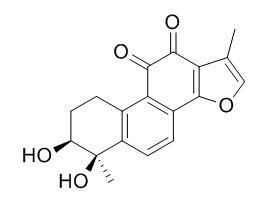Tanshindiol B
Tanshindiol B possesses a unique anti-cancer activity whose mechanism involves the inhibition of EZH2 activity and would provide chemically valuable information for designing a new class of potent EZH2 inhibitors. It also possesses the anti-angiogenic activity,so it can be a promising candidate for angiogenesis inhibitors.
Inquire / Order:
manager@chemfaces.com
Technical Inquiries:
service@chemfaces.com
Tel:
+86-27-84237783
Fax:
+86-27-84254680
Address:
1 Building, No. 83, CheCheng Rd., Wuhan Economic and Technological Development Zone, Wuhan, Hubei 430056, PRC
Providing storage is as stated on the product vial and the vial is kept tightly sealed, the product can be stored for up to
24 months(2-8C).
Wherever possible, you should prepare and use solutions on the same day. However, if you need to make up stock solutions in advance, we recommend that you store the solution as aliquots in tightly sealed vials at -20C. Generally, these will be useable for up to two weeks. Before use, and prior to opening the vial we recommend that you allow your product to equilibrate to room temperature for at least 1 hour.
Need more advice on solubility, usage and handling? Please email to: service@chemfaces.com
The packaging of the product may have turned upside down during transportation, resulting in the natural compounds adhering to the neck or cap of the vial. take the vial out of its packaging and gently shake to let the compounds fall to the bottom of the vial. for liquid products, centrifuge at 200-500 RPM to gather the liquid at the bottom of the vial. try to avoid loss or contamination during handling.
Phytomedicine.2019, 57:95-104
Protoplasma.2024, 261(6):1267-1280.
Food Chem.2023, 404(Pt A):134517.
Microchemical Journal2018, 137:168-173
BMC Plant Biol.2023, 23(1):239.
Microchemical Journal2023, 194:109249
Food Sci Biotechnol.2023, 32(7):997-1003.
J of Food Quality2020, 8851285.
BMC Complement Altern Med.2019, 19(1):325
J of the Korean Society of Cosmetics and Cosmetology2018, 399-406
Related and Featured Products
Bioorganic & Medicinal Chemistry Letters, 2014, 24(11):2486-2492.
Biological evaluation of tanshindiols as EZH2 histone methyltransferase inhibitors.[Reference:
WebLink]
EZH2 is the core subunit of Polycomb repressive complex 2 catalyzing the methylation of histone H3 lysine-27 and closely involved in tumorigenesis.
METHODS AND RESULTS:
To discover small molecule inhibitors for EZH2 methyltransferase activity, we performed an inhibitor screen with catalytically active EZH2 protein complex and identified tanshindiols as EZH2 inhibitors. Tanshindiol B and Tanshindiol C potently inhibited the methyltransferase activity in in vitro enzymatic assay with IC50 values of 0.52 μM and 0.55 μM, respectively. Tanshindiol C exhibited growth inhibition of several cancer cells including Pfeiffer cell line, a diffuse large B cell lymphoma harboring EZH2 A677G activating mutation. Tanshindiol treatment in Pfeiffer cells significantly decreased the tri-methylated form of histone H3 lysine-27, a substrate of EZH2, as revealed by Western blot analysis and histone methylation ELISA. Based on enzyme kinetics and docking studies, we propose that tanshindiol-mediated inhibition of EZH2 activity is competitive for the substrate S-adenosylmethionine.
CONCLUSIONS:
Taken together, our findings strongly suggest that tanshindiols possess a unique anti-cancer activity whose mechanism involves the inhibition of EZH2 activity and would provide chemically valuable information for designing a new class of potent EZH2 inhibitors.
Chinese Traditional Patent Medicine, 2014, 36(6):1146-1150.
Tanshindiol B from Salvia przewalskii inhibits angiogenic activity.[Reference:
WebLink]
To study the effect of Tanshindiol B from Salvia przewalskii Maxim. on angiogenic activity.
CONCLUSIONS:
Tanshindiol B was isolated from acetonic extract of S. przewalskii and purified by the silica gel column and Sephadex LH-20 column chromatography. MTT method was employed to explore the effect of Tanshindiol B on the migration and the expression of human umbilical vein endothelial cells(HUVEC) and to measure the vascular endothelial growth factor(VEGF) level. The chicken chorioallantoic membrane(CAM) model was used for in vivo inhibition of angiogenic activity. Tanshindiol B could inhibit the proliferation and migration of HUVEC,angiogenesis on CAM,and the secrete of VEGF in a dose-dependent manner.
CONCLUSIONS:
Tanshindiol B possesses the anti-angiogenic activity,so it can be a promising candidate for angiogenesis inhibitors.
Phytochemistry, 1985, 24(4):815-817.
Pigments from Salvia miltiorrhiza.[Reference:
WebLink]
METHODS AND RESULTS:
Five new o-naphthaquinone diterpenes, tanshindiol A, Tanshindiol B, tanshindiol C, nortanshinone and 3α-hydroxytanshinone IIA, have been isolated from the roots of Salvia miltiorrhiza as minor components. Their relative stereochemistries have been established on the basis of spectral and chemical evidence.



